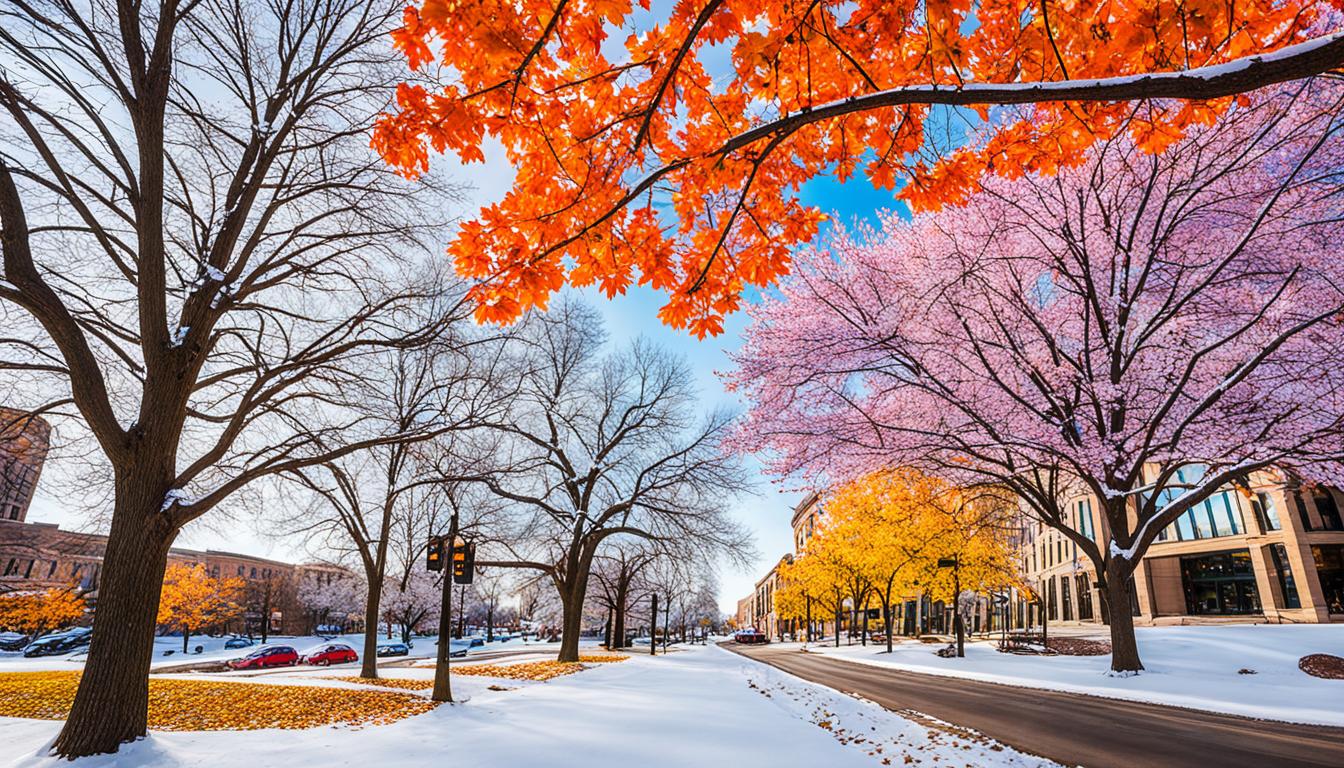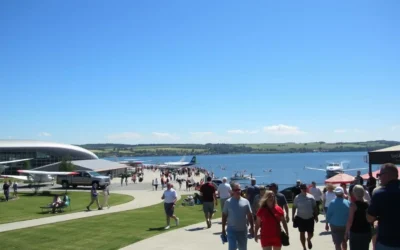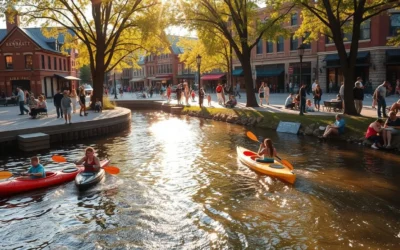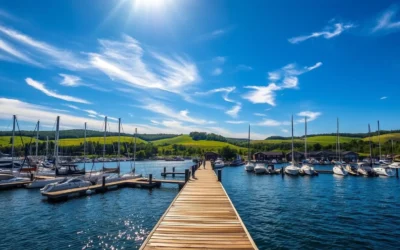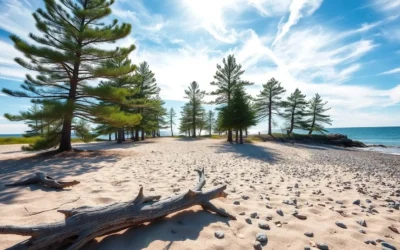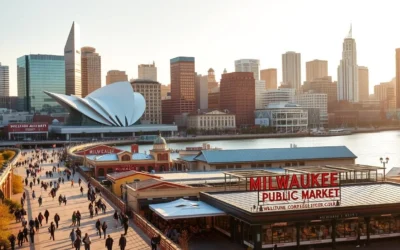✓ Accommodations✓ Flights✓ Rental Cars
Are you planning a trip to Milwaukee, Wisconsin? Wondering when is the best time to visit this vibrant city and experience its unique charm? Well, we’ve got the answers you’re looking for! In this comprehensive guide, we’ll walk you through the best months to visit Milwaukee based on its weather patterns. So, let’s dive in and discover the ideal time to plan your weather-savvy trip to Milwaukee!
Key Takeaways:
- Find out when to visit Milwaukee, Wisconsin based on the weather conditions and climate.
- Explore the beauty of spring, summer, fall, and winter in Milwaukee.
- Understand Milwaukee’s weather patterns and how they can impact your trip.
- Learn how to convert between Fahrenheit and Celsius temperature scales for accurate weather forecasts.
- Get valuable tips and recommendations for planning a weather-savvy trip to Milwaukee.
Milwaukee Weather Overview
Plan your visit to Milwaukee, Wisconsin with a detailed overview of the city’s weather patterns. Understanding the seasonal variations, average temperatures, precipitation levels, and other relevant climate information can help you make an informed decision about when to visit.
Seasonal Variations
Milwaukee experiences four distinct seasons, each offering its own unique charm. From the blossoming of spring to the vibrant fall foliage, and from sunny summers to snowy winters, there’s something for everyone throughout the year.
Average Temperatures
In summer (June to August), Milwaukee enjoys warm temperatures, with average highs ranging from 77°F (25°C) to 82°F (28°C). Spring (March to May) and fall (September to November) bring mild temperatures, with highs averaging between 50°F (10°C) and 70°F (21°C). Winter (December to February) is chilly, with average highs ranging from 30°F (-1°C) to 36°F (2°C).
Precipitation Levels
Milwaukee receives rainfall throughout the year, with the summer months being the wettest. The city typically sees an average of 3 to 4 inches of precipitation per month, providing lush greenery and contributing to the beauty of its parks and gardens.
Climate Information
Milwaukee has a humid continental climate, characterized by warm summers and cold, snowy winters. It experiences moderate humidity levels with a fair amount of sunshine, making it an enjoyable destination for outdoor activities.
“Milwaukee’s weather offers a delightful blend of seasonal beauty and diverse outdoor experiences, making it a year-round destination for visitors.”
| Season | Average Temperature | Precipitation Levels |
|---|---|---|
| Spring (March to May) | 50°F (10°C) to 70°F (21°C) | 3-4 inches per month |
| Summer (June to August) | 77°F (25°C) to 82°F (28°C) | 3-4 inches per month |
| Fall (September to November) | 50°F (10°C) to 70°F (21°C) | 3-4 inches per month |
| Winter (December to February) | 30°F (-1°C) to 36°F (2°C) | 2-3 inches per month |
Whether you prefer the warmth of summer, the colorful foliage of fall, or the winter wonderland, Milwaukee has something to offer every season. Use this weather overview as a guide to plan your trip and make the most of your visit to this vibrant city.
Spring in Milwaukee
Experience the vibrant beauty of spring in Milwaukee, Wisconsin. As the winter frost melts away, the city comes alive with blossoming flowers, lush greenery, and a renewed energy that signifies the arrival of a new season. Spring is one of the best times to visit Milwaukee, offering an ideal climate and a plethora of events and festivals to delight travelers of all interests.
When it comes to planning your trip, the best months to visit Milwaukee in the spring are April and May. During these months, the weather starts to warm up, with average temperatures ranging from 50°F (10°C) to 70°F (21°C). It is the perfect time to explore the city’s numerous parks, walk along the picturesque Lake Michigan shoreline, and discover the charming neighborhoods that make Milwaukee unique.
One of the highlights of spring in Milwaukee is the abundance of events and festivals that take place during this season. From the Lakefront Brewery Beer Run to the Milwaukee Art Museum’s Art in Bloom, there is something for everyone to enjoy. The city also hosts the annual Wisconsin State Fair, a must-visit event featuring live music, carnival rides, delicious food, and much more.
Spring is a time of new beginnings, and Milwaukee showcases its vibrant spirit during this season. From the blooming flowers to the lively events, you’ll find plenty of reasons to fall in love with the city. Don’t miss out on exploring Milwaukee in the spring for an unforgettable experience.
Summer in Milwaukee
Are you ready to make the most of your trip to Milwaukee? Plan your visit during the summer months, when the city comes alive with endless opportunities for fun and adventure. From outdoor activities to exciting festivals, Milwaukee in summer offers a vibrant atmosphere that will leave you with unforgettable memories.
So, what are the best months to visit Milwaukee during the summer? The top months for a trip to Milwaukee are June, July, and August. These months boast pleasant weather, with warm temperatures and long, sunny days.
During your summer stay in Milwaukee, take advantage of the city’s beautiful parks and waterfront areas. Explore the scenic beauty of the Lake Michigan shoreline, go hiking, or rent a kayak for a thrilling adventure on the water.
Outdoor Festivals and Events
One of the highlights of a summer trip to Milwaukee is the wide range of festivals and events held throughout the season. From music festivals to food festivals, there’s something for everyone to enjoy.
“Milwaukee in the summer is festival season, and you don’t want to miss out on the fun and excitement. Whether you’re a music lover, a foodie, or an art enthusiast, there’s a festival that will capture your interest and make your trip truly memorable.”
Some of the popular summer festivals in Milwaukee include Summerfest, the world’s largest music festival, and German Fest, which celebrates the city’s German heritage. These festivals showcase live music, delicious food, cultural exhibits, and thrilling entertainment.
The Vibrant Atmosphere
Summer in Milwaukee brings a bustling and energetic vibe to the city. With locals and visitors alike taking to the streets, the city comes alive with an infectious energy. Explore the lively neighborhoods, indulge in delicious food from local eateries, and soak up the friendly atmosphere that makes Milwaukee a special place to visit.
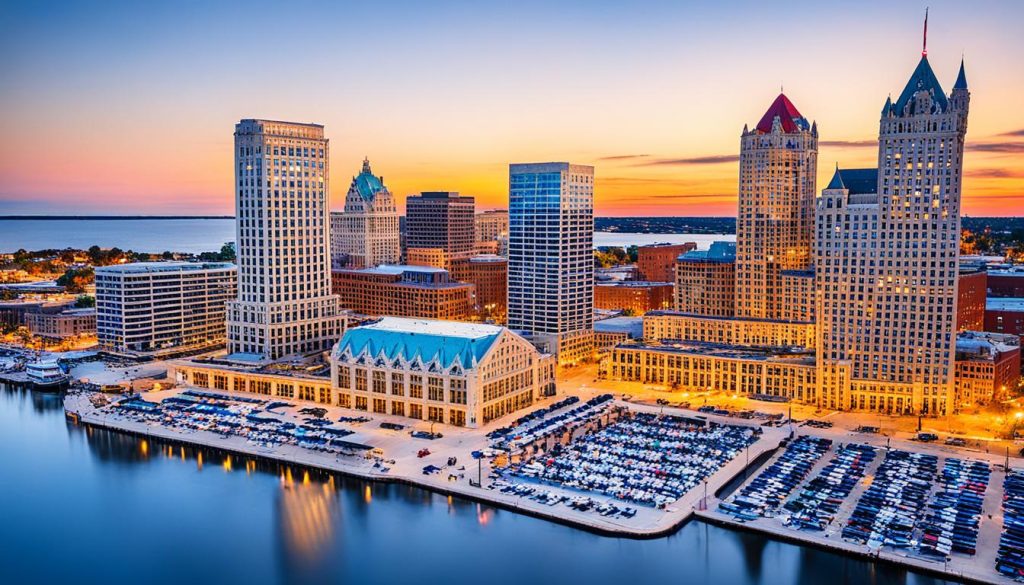
Fall in Milwaukee
Delve into the charm of fall in Milwaukee and discover the ideal months to visit this vibrant city. As summer gives way to autumn, Milwaukee’s parks transform into a colorful landscape, providing a breathtaking backdrop for outdoor activities and events.
Best Months to Visit Milwaukee
The best months to experience the beauty of fall in Milwaukee are September, October, and November. During these months, the city enjoys mild temperatures, ranging from the high 50s to low 70s Fahrenheit (14-23 degrees Celsius), making it perfect for exploring the foliage and engaging in various outdoor adventures.
September marks the transition from summer to fall, with comfortable temperatures and fewer crowds. It’s an excellent time to explore Milwaukee’s parks, such as Lake Park and Grant Park, where you can witness the vibrant colors of the changing leaves.
In October, as the foliage reaches its peak, Milwaukee hosts delightful harvest festivals, including the famous Cedarburg Wine & Harvest Festival and the Apple Harvest Festival. These events showcase the region’s agricultural heritage and offer an array of delicious food, live music, and fun-filled activities for the whole family.
November brings a serene atmosphere to Milwaukee, as the city prepares for the holiday season. Art enthusiasts can enjoy exploring the Milwaukee Art Museum, which hosts captivating fall-inspired exhibits, while nature lovers can take peaceful walks along the Milwaukee Riverwalk and enjoy stunning views of the fall foliage reflected in the water.
Milwaukee Travel Tips
- Don’t forget to pack layers of clothing, as fall temperatures can fluctuate throughout the day.
- Make sure to bring a camera to capture the beautiful fall colors and memorable moments.
- Check the local event calendar to plan your visit around fall festivals and art exhibits.
- Consider taking a guided tour to learn more about Milwaukee’s history, architecture, and fall traditions.
- Indulge in seasonal treats like caramel apples and pumpkin-flavored treats offered by local bakeries and restaurants.
A trip to Milwaukee in the fall is not complete without immersing yourself in the breathtaking beauty of the changing leaves, savoring seasonal delicacies, and embracing the city’s vibrant fall culture.
Fall Events in Milwaukee
| Event | Date | Description |
|---|---|---|
| Cedarburg Wine & Harvest Festival | September 18-19, 2021 | A two-day celebration of the harvest season featuring wine tastings, live music, arts and crafts, and more. |
| Apple Harvest Festival | October 2-3, 2021 | A family-friendly event showcasing apple varieties, delicious treats, live entertainment, and fun activities. |
| Milwaukee Film Festival | October 21-October 30, 2021 | An annual film festival featuring a diverse range of movies, documentaries, and shorts from around the world. |
| Dia de los Muertos Parade & Festival | November 6, 2021 | A vibrant celebration of the Day of the Dead with a colorful parade, music, dancing, and traditional Mexican cuisine. |
Winter in Milwaukee
Embrace the winter wonderland of Milwaukee and discover the best months to visit during the snowy season. From thrilling outdoor activities to festive celebrations, Milwaukee offers a unique winter experience that you won’t want to miss.
When visiting Milwaukee in winter, you’ll have the opportunity to enjoy a variety of outdoor activities. Lace up your skates and glide across the ice at the renowned Red Arrow Park Ice Rink. Ski enthusiasts can hit the slopes at nearby mountain resorts such as Alpine Valley Resort. And if you prefer a more leisurely winter experience, take a scenic snowshoeing or cross-country skiing adventure in one of Milwaukee’s beautiful parks.
Winter Festivals and Events
Milwaukee truly comes alive during the winter season with a multitude of festivals and events that celebrate the city’s winter spirit. One of the highlights is the Milwaukee Winter Farmers Market, where you can browse through fresh produce, artisan goods, and delectable treats. Another must-visit event is the Jazz in the Park Concert Series, which showcases talented musicians performing in a cozy indoor setting.
Experience the magic of the Milwaukee Holiday Lights Festival, where the city’s streets and parks are adorned with dazzling light displays. Take a romantic carriage ride through downtown Milwaukee or enjoy a cup of hot cocoa as you stroll through Cathedral Square Park.
Splendid Winter Cuisine
A visit to Milwaukee in winter is an opportunity to savor delicious seasonal cuisine that warms the soul. Indulge in comforting dishes like hearty stews, warm apple pies, and rich hot chocolate at cozy restaurants and cafes throughout the city. Don’t forget to try the local delicacy, cheese curds, which are especially satisfying during the colder months.
| Winter in Milwaukee Highlights | Best Months to Visit |
|---|---|
| Winter sports and activities | December – February |
| Milwaukee Winter Farmers Market | November – March |
| Milwaukee Holiday Lights Festival | November – January |
| Jazz in the Park Concert Series | January – March |
| Winter cuisine and dining | December – February |
So bundle up and explore the winter wonders of Milwaukee during the best months to visit. Whether you’re seeking adventure on the slopes, immersing yourself in vibrant festivals, or indulging in cozy cuisine, Milwaukee has something to offer every winter enthusiast.
Understanding Milwaukee’s Weather Patterns
Gaining insights into Milwaukee’s weather patterns can greatly influence your trip to this vibrant city. By understanding the typical temperature ranges, rainfall distribution, and other weather-related factors, you can plan your visit more effectively and make the most of your time in Milwaukee.
Let’s take a closer look at some key aspects of Milwaukee’s weather patterns:
Temperature Ranges
Milwaukee experiences a wide range of temperatures throughout the year. Summers are warm and humid, with average temperatures ranging from the high 70s to mid-80s degrees Fahrenheit (25-30 degrees Celsius). Winters, on the other hand, are cold and snowy, with temperatures dropping to the teens and occasionally below zero Fahrenheit (-10 to -20 degrees Celsius).
Precipitation and Rainfall
Milwaukee receives a significant amount of rainfall throughout the year, with the wettest months being June, July, and August. On average, the city gets around 33 inches (84 centimeters) of rain annually. Snowfall is also common during the winter months, with Milwaukee receiving an average of 47 inches (120 centimeters) of snowfall each year.
Seasonal Variations
Milwaukee experiences distinct seasons, each with its own unique charm and activities. Spring brings blooming flowers, mild temperatures, and a vibrant atmosphere. Summer is the perfect time to explore Milwaukee’s outdoor attractions and enjoy festivals and events. Fall showcases the city’s beautiful autumn foliage and harvest celebrations. Winter offers opportunities for winter sports and festive holiday events.
Understanding Milwaukee’s weather patterns will allow you to plan ahead and pack accordingly. Whether you’re visiting in the summer or winter, it’s always a good idea to check the forecast closer to your trip to ensure you’re prepared for the current weather conditions.
| Season | Average Temperature (Fahrenheit) | Average Temperature (Celsius) | Weather Highlights |
|---|---|---|---|
| Spring | 40-60°F | 4-16°C | Blooming flowers, mild temperatures |
| Summer | 70-85°F | 21-29°C | Outdoor activities, festivals |
| Fall | 40-60°F | 4-16°C | Autumn foliage, harvest celebrations |
| Winter | 15-30°F | -9 to -1°C | Snowy, winter sports, holiday events |
With this knowledge of Milwaukee’s weather patterns, you can plan your trip accordingly and make the most of your time exploring this vibrant city.
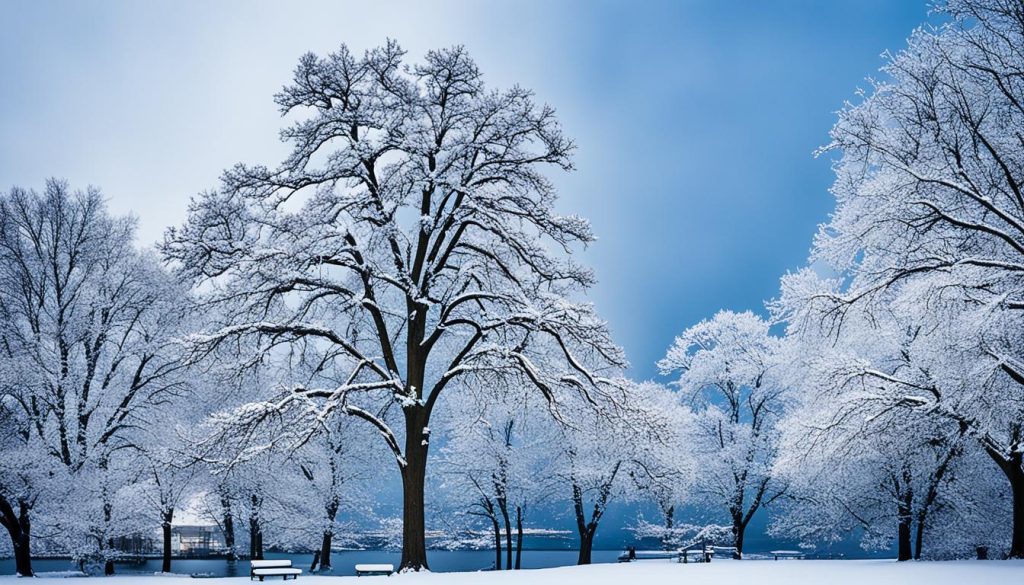
Fahrenheit and Celsius Conversion
If you’re unfamiliar with temperature scales, such as Fahrenheit and Celsius, don’t worry. We have all the information you need to understand the weather forecasts and readings in Milwaukee.
Understanding Fahrenheit and Celsius
Fahrenheit (°F) and Celsius (°C) are the two most commonly used temperature scales. While Fahrenheit is primarily used in the United States, Celsius is more widely used in many other parts of the world.
“The Fahrenheit scale was developed by the physicist Daniel Gabriel Fahrenheit in the early 18th century. On this scale, water freezes at 32°F and boils at 212°F. The Celsius scale, on the other hand, was developed by the Swedish astronomer Anders Celsius in the 18th century. Water freezes at 0°C and boils at 100°C.”
Converting Fahrenheit to Celsius
To convert a temperature from Fahrenheit to Celsius, you can use the following formula:
°C = (°F – 32) x 5/9
Let’s say the temperature in Milwaukee is 70°F. To convert it to Celsius:
- Subtract 32 from the Fahrenheit temperature: 70 – 32 = 38
- Multiply the result by 5/9: 38 x 5/9 = 21.1
The temperature in Celsius would be approximately 21.1°C.
Converting Celsius to Fahrenheit
If you have a temperature in Celsius and want to convert it to Fahrenheit, you can use the following formula:
°F = (°C x 9/5) + 32
Let’s take an example where the temperature in Milwaukee is 25°C. To convert it to Fahrenheit:
- Multiply the Celsius temperature by 9/5: 25 x 9/5 = 45
- Add 32 to the result: 45 + 32 = 77
The temperature in Fahrenheit would be approximately 77°F.
Now that you understand how to convert between Fahrenheit and Celsius, you can confidently interpret the weather forecasts and readings in Milwaukee.
Planning Your Weather-Savvy Trip to Milwaukee
When planning a trip to Milwaukee, Wisconsin, it’s important to consider the weather and climate to ensure a memorable experience. To help you make the most of your visit, we’ve put together some valuable tips and recommendations for a weather-savvy trip.
First and foremost, familiarize yourself with the weather patterns in Milwaukee. While the city experiences four distinct seasons, the weather can be unpredictable at times. Be prepared for temperature fluctuations and pack accordingly. Layered clothing is always a good idea, as it allows you to adjust to changing weather conditions throughout the day.
If you’re visiting during the warmer months, such as spring or summer, make sure to pack sunscreen, a hat, and comfortable walking shoes. These essentials will come in handy as you explore Milwaukee’s beautiful parks, waterfront areas, and vibrant neighborhoods.
For those planning a trip during fall or winter, don’t forget to pack warm clothing, including a jacket, gloves, and a hat. You’ll want to be prepared for colder temperatures, especially if you’re looking forward to participating in winter activities like ice skating or attending holiday festivals.
Pro Tip: Check the weather forecast before your trip and keep an eye on any potential changes or severe weather warnings. It’s always a good idea to stay informed and plan accordingly.
“Milwaukee is a city of beautiful contrasts – from the lush greenery of its parks in spring to the stunning autumn foliage and winter wonderland. As a weather-savvy traveler, make sure to pack for different climates and seasons to fully embrace the city’s charm.”
Must-Visit Attractions
Regardless of the season, Milwaukee has a wide range of attractions and activities to offer. Here are some must-visit places to include in your itinerary:
- The historic Milwaukee Art Museum, known for its stunning architecture and extensive art collection.
- The Milwaukee Public Market, where you can indulge in delicious local cuisine and shop for unique treats.
- The Harley-Davidson Museum for motorcycle enthusiasts and those interested in the city’s rich industrial history.
- The Milwaukee County Zoo, home to a diverse range of animal species and engaging exhibits.
- The scenic Milwaukee Riverwalk, perfect for a leisurely stroll and enjoying picturesque views of the city.
These are just a few examples of the many attractions you can explore in Milwaukee. Don’t forget to research and prioritize based on your interests and the time you have available.
Insider Recommendations
To make the most of your trip, consider these insider recommendations:
- Explore the city’s vibrant neighborhoods, such as the Historic Third Ward or Brady Street, to experience the local culture and cuisine.
- Take a brewery tour to learn about Milwaukee’s beer-making history and enjoy some craft brews along the way.
- Attend one of the city’s festivals, such as Summerfest or Polish Fest, to immerse yourself in the lively atmosphere and celebrate Milwaukee’s diverse traditions.
- Visit one of the city’s many microbreweries or distilleries to taste locally crafted beverages and support the thriving craft beverage scene in Milwaukee.
- Don’t miss the opportunity to catch a game at Miller Park, home to the Milwaukee Brewers. Experience the excitement of a baseball game and join in the local pride.
These insider recommendations will help you discover some hidden gems and create lasting memories during your time in Milwaukee.
Additional Considerations
When planning your weather-savvy trip to Milwaukee, keep the following considerations in mind:
- Book accommodation in advance, especially during peak tourist seasons, to secure the best rates and availability.
- Research public transportation options, such as the Milwaukee County Transit System, to navigate the city conveniently.
- Check if any major events or conventions are taking place during your visit, as they may impact hotel availability and crowds.
- Consider purchasing a CityPASS or exploring bundled ticket options for attractions to save money and make the most of your time in Milwaukee.
By considering these additional factors and incorporating them into your trip planning, you’ll be well-prepared to enjoy all that Milwaukee has to offer.
| Packing Essentials | Spring/Summer | Fall/Winter |
|---|---|---|
| Comfortable walking shoes | ✔ | ✔ |
| Sunscreen and a hat | ✔ | |
| Jacket, gloves, and a hat | ✔ | |
| Layered clothing | ✔ | ✔ |
Remember, planning a weather-savvy trip to Milwaukee involves considering the seasons, packing appropriately, and taking advantage of the city’s must-visit attractions and insider recommendations. By doing so, you’ll create unforgettable memories and make the most of your time in this vibrant city.
Conclusion
After exploring the different seasons and weather patterns in Milwaukee, Wisconsin, you’re now equipped to plan the perfect weather-savvy trip to this vibrant city. Consider visiting during the spring months, when nature flourishes and the city comes alive with exciting events and festivals. Summer offers a plethora of outdoor activities and a vibrant atmosphere, making it another fantastic time to visit.
If you’re a fan of colorful landscapes and fall-inspired events, plan your trip during autumn, where you can witness the city’s parks transform into an enchanting display of colors. For those who enjoy winter activities, embrace the snowy season by visiting Milwaukee during the best winter months, where ice skating, skiing, and festive celebrations await.
By understanding Milwaukee’s weather patterns and using the insights provided in this guide, you’ll be able to make informed decisions while planning your trip. Whether you prefer warm weather adventures or embrace the beauty of the changing seasons, Milwaukee offers something for everyone throughout the year. Pack accordingly, and get ready for an unforgettable journey in one of the most vibrant cities in Wisconsin.
FAQ
What are the best months to visit Milwaukee, Wisconsin for a weather-savvy trip?
What is the weather like in Milwaukee?
When is spring in Milwaukee and why is it a great time to visit?
What are the best months to visit Milwaukee in summer?
What can I expect during fall in Milwaukee?
When is the winter season in Milwaukee, and what can I do during this time?
How can I understand Milwaukee’s weather patterns?
How do I convert between Fahrenheit and Celsius?
What are some tips for planning a weather-savvy trip to Milwaukee?
The above is subject to change.
Check back often to TRAVEL.COM for the latest travel tips and deals.
